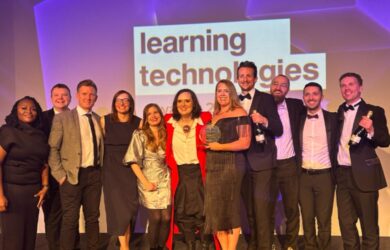 The Three Box Solution, brainchild of professor and best-selling author Vijay Govindarajan, is as simple as its name. There’s a box each for the present, the past, and the future. The “solution“ refers to the question at the heart of all innovation strategy: how do you create your future while managing the present?
The Three Box Solution, brainchild of professor and best-selling author Vijay Govindarajan, is as simple as its name. There’s a box each for the present, the past, and the future. The “solution“ refers to the question at the heart of all innovation strategy: how do you create your future while managing the present?
“If a company wants to become a leader in the year 2025, it’s not about what you have to do in the year 2025. It‘s about what you have to do now, across the three boxes,” Govindarajan explains. After all, “the future comes in daily doses. The future doesn’t arrive all at once. Therefore every company must focus on today and tomorrow every day. That’s the idea behind the Three Box Solution.“
Govindarajan sets out the details of this framework in his book titled, “The Three Box Solution, A Strategy for Leading Innovation.” In our Expert Interview podcast, we delve into the practicalities of this idea and unravel some of the terms. For example, what is the difference between linear and nonlinear innovation?
“Linear innovation is box one [the present]. There, you are innovating around your current business model. That’s all efficiency. Nonlinear innovation is box three [the future]. That’s breakthrough innovation. Therefore, if an organization has to become a leader in the year 2025, you have to really excel in linear innovation plus you have to excel in nonlinear innovation,” he says.
As an example, we talk about Ford Motor Company.
“Ford invented and innovated the mass market for automobiles with the Model T at the turn of the 20th century. For the last 100 years, the automobile industry was excelling using mechanical engineering, designing engines and shafts and pistons and so on,” Govindarajan says. “So in the year 2016, if you are the Ford Motor Company, you have a box one job: you have a competition for the present. You have linear innovation, which is to continually improve gasoline-powered automobiles.
“However, if Ford has to become a leader in the year 2025 in the automotive industry, it has to excel also in nonlinear innovation. Think about driverless cars, think about electric cars, think about the sharing economy like Über – that requires Ford to build completely new core competencies in computer science, artificial intelligence, and robotics.“
So the company has two jobs to do simultaneously.
“One job is to improve the efficiency of your box one businesses, which is gasoline-powered automobiles. The other job is to invent your future with driverless cars and electrics cars and the sharing economy etc.”
The central challenge for every organization is “to decide how much of the portfolio should be in linear innovation [box one, the present] and how much of the portfolio should be in nonlinear innovation [box three, the future],” Govindarajan concludes.
So what about box two, the past? According to Govindarajan, this is the most difficult box, because you need to know what to forget (“chains”) and what to hold on to (“roots”).
“Every organization has roots, every organization has chains,” he states. “If you cut the roots, the tree dies. Therefore, you had better understand what your roots are, preserve it, nurture it, fertilize it, strengthen it, keep it forever. Every organization is also held to the past with chains. That’s what you should break loose from.”
To consider box two in action, let’s return to the Ford Motor Company.
“One of the chains they must break loose from is exclusive focus on mechanical engineering, and unless they forget that logic, they will never get to the future,” Govindarajan believes, adding more generally, ”What you need to forget is a future weakness but it is embedded in your current strength, and that’s why forgetting is difficult.“
It’s clear that, although the strategy is simple, its execution can be complex. One way to make this work is by compartmentalizing your teams according to their focus.
“So if you’re the Ford Motor Company, you have to create a dedicated team for electric cars… and the dedicated team should have some separation from the box one [present] performance engine, so that you can forget the rules of the game of box one,” Govindarajan advises. ”When you create a dedicated team, it simultaneously achieves box two, forgetting. But also, if the team is put together correctly with computer scientists and artificial intelligence and robotics people… you build the right capability. So simultaneously box two [the past] and box three [the future] are two sides of the same coin.“
Once you have your teams set up according to their box, or focus, where does the actual innovation come from? Govindarajan talks about “planned opportunism,” an idea based on reading “weak signals.” In this audio clip, from our Expert Interview podcast, he explains what these are and how they can be picked up.
Listen to the full Expert Interview in the Mind Tools Club ¦ Install Flash Player.
How do you and your team plan for innovation? Join the discussion below!




Comments
Jennie Cabajar says
8 years agoIt's must be hard to let go and cut the roots that is embedded in the present, but sometimes we need to sacrifice in order to save certain things for the betterment of the future. And today's generation, competition in technology with AI and programming rises to its highest level, just like you said, Ford should be up on trend to stay on top.
Midgie Thompson says
8 years agoThanks for sharing your thoughts Jennie. As you say, sometimes we need to let go all in view of a better future!
Daniel says
8 years agoI am agree with you the one should make strategy before starting any work and follow it strictly because planned actions brings always rich fruits.
Midgie Thompson says
8 years agoThanks Daniel for sharing your thoughts. I always believe that when we take the time first to plan and organize ourselves, we are so much more productive!
Sai says
8 years agoInteresting. It is relevant for individuals as well as organizations. For example, we need to focus on our present day job and be more efficient but some time must go toward creating the future. My takeaway from this blog post.
Yolande Conradie says
8 years agoThat's a great takeaway - thanks for sharing, Sai. It's always about finding that all-important balance.